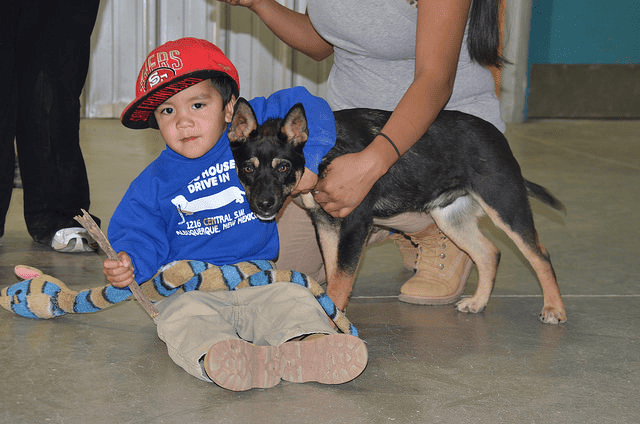Seasonal Pet Safety

Whether you’re a pet parent, a stray sympathizer, or a mix of both, every season has unique challenges for animals.
This guide aims to help you keep your pets in tip-top shape throughout the year and extend a paw to strays that could use a helping hand.
Spring
Ah, springtime… The birds are singing, the flowers are blooming, and pets everywhere are itching—sometimes literally—to get outside. But it’s also the season when pollen flies and critters crawl, so we’ve got some work to do.
- For Your Pets
- For Strays
Allergy Alert
Spring allergies don’t only affect humans. Our furry friends can be sniffling and itching, too. One way to mitigate this is to wipe down your pet’s coat and paws with a damp cloth after walks to remove allergens, especially if you’ve been in particularly grassy or wooded areas.
Tick and Flea Prevention
As the snow melts, ticks and fleas come out to play. If you don’t already have a tick and flea prevention program, now is the time to start one.
Update Vaccinations
After hibernating through the winter, chances are your pets will interact more with other animals. Spring is a fantastic time to consult your vet and make sure all their vaccinations are up to date.
Fresh Water
The sun starts to heat things up in spring, and water sources can be scarce. One simple way to make a big impact is placing bowls of fresh water in your yard or community spaces where strays often wander.
Build a Feeding Station
Strays need to eat, but their food shouldn’t be wet and soggy from springtime rain showers.
Using a plastic tote, you can quickly build a makeshift feeding station. Cut an entry hole, place the food inside, and secure the lid to shield the food from rain.
It’s an afternoon project that can make a world of difference.

Summer
With summer’s lazy, hazy days come pools, picnics, and endless play. Unfortunately, summer’s heat can be a double-edged sword for animals.
- For Your Pets
- For Strays
Stay Hydrated
Summer temperatures can be brutal, so make it a habit to always keep water handy for your pets. Portable water bottles designed for pets are a lifesaver during hot summer days.
Avoid Hot Pavements
Imagine walking barefoot on hot pavement. Ouch! Your pets feel the same way.
During the hot summer months, it’s best to walk your pets early in the morning or late in the evening when the ground is cooler. If that’s not possible, you can fashion makeshift booties from old socks and some Velcro straps to offer some insulation from the heat.
Cooling Mats
If you’ve got some sewing skills, make a simple DIY cooling mat.
Fill a fabric pouch with ice packs or frozen bags of rice, then sew it shut. Place the mat where your pet likes to relax, and you’ve just created a chill zone. Just stick it back in the freezer when it’s not in use, and your precious companion will always have a cool place to rest.
Leave Ice Water
You can help neighborhood strays beat the heat by leaving out bowls filled with ice water. Ice takes longer to melt and will provide a longer-lasting water source on scorching hot days.
Provide Shade
When the temperature climbs, a little shade goes a long way. Tack up a simple tarp or cloth shelter in your yard or other areas where strays tend to hang out. They’ll be grateful for the oasis from the heat.

Autumn
Those crisp, cool walks among the falling leaves are heaven, aren’t they? But fall comes with its own pet precautions to look out for.
- For Your Pets
- For Strays
Coat Care
Autumn is often the time when pets begin to shed their summer coats to prepare for winter. It is also a fantastic opportunity for you to brush your pets more frequently, which helps remove loose fur and dander and promotes healthier skin.
Check for Ticks
Even though the weather is getting cooler, ticks haven’t gotten the memo. They’re still around, especially in areas with tall grass and bushes. Make it a habit to check your pet for ticks after those long, enjoyable autumn walks.
Be Mindful of Rodents
When the temperatures start to dip, rodents seek warmth, which could lead them straight into your home, garage, or shed. Often, these rodents carry fleas that could then transfer to your pets. Make sure to seal off any small openings where these uninvited guests could enter.
Warm Bedding
The nights get colder in autumn, and strays need all the warmth they can get. If you have any old blankets, consider placing them in a plastic tote or wooden box, which you can leave in a sheltered area. Fill the box with straw for added insulation, and create a warm, cozy den for strays.
Note: If you live in a particularly damp area, skip the blankets! They absorb moisture better than straw, and can mildew in the heat of the day.
Food Supplies
As the temperature drops, strays need more calories to stay warm. Consider increasing the amount of food you put out at your DIY feeding stations. Wet food is beneficial as it’s easier to eat and offers added hydration.

Winter
For many of us, winter is the most wonderful time of the year. Unfortunately, it’s often the harshest for both pets and strays.
- For Your Pets
- For Strays
Keep Them Warm
Keep your pets cozy in the cold by repurposing old sweatshirts or blankets into pet-friendly sweaters. Cut holes for the legs and head large enough for your pet to put their heads and legs through comfortably.
Limit Outdoor Time
Frostbite and hypothermia are real threats to pets in winter. Limit the amount of time they spend outdoors and keep walks short. Consider indoor games like fetch or agility courses in a spacious living area if you have an active dog.
Prevent Antifreeze Ingestion
Antifreeze is incredibly poisonous for pets and has a sweet taste that may attract them. Double check that all containers are tightly sealed and stored out of reach, and clean up spills immediately.
Build a Shelter
Strays have it hardest in winter. But you can help by constructing simple, insulated shelters using plastic storage bins and foam boards.
Line the interior with straw—not blankets, as they can absorb moisture and freeze—and place the shelter in a secluded spot.
High-Calorie Foods
Strays need to maintain their body heat, which requires a lot of energy. Fatty foods like chicken skin or a bit of gravy mixed in with dry kibble can provide those much-needed calories.

Give Animals in Tribal Communities a Fighting Chance
Support the Native American Humane Society’s mission to empower tribal communities to manage and care for their animal populations. Make a difference today.




